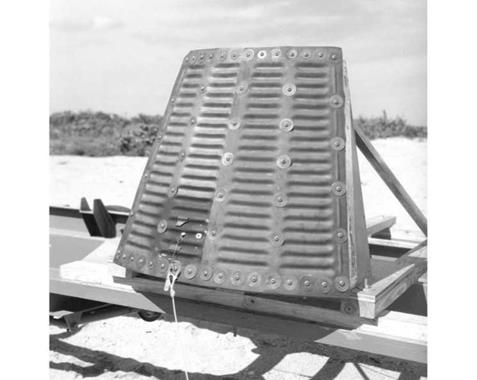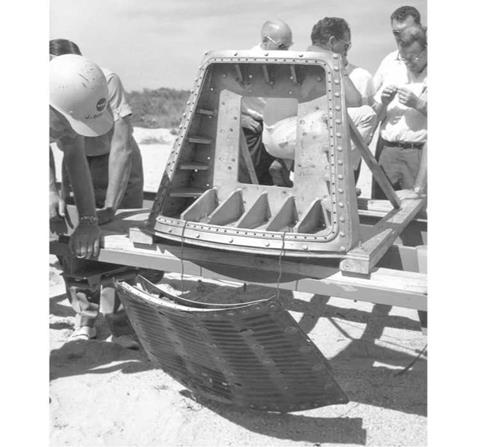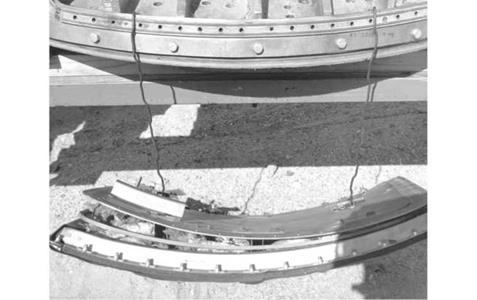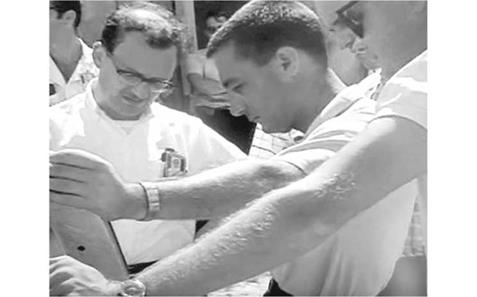GRISSOM NAMED TO FLIGHT
On Thursday, 29 June, NASA said there were tentative plans to launch the MR-4 mission on a downrange suborbital flight from Cape Canaveral during the week of 16 July. They said the name of the chosen astronaut would be revealed on Monday, but everyone expected the pilot to be John Glenn, with Grissom on the third flight. NASA also revealed that it had originally planned to launch the second Redstone rocket and capsule just six weeks after Shepard’s flight. However it was forced to delay these plans because of changes made in the capsule in response to Shepard’s recommendations. The bulletin stated that it was expected that the astronaut on this flight would have fewer tasks to perform, and have more time available for Earth observation.
On 10 July Grissom was an interested spectator at a demonstration of the explosive hatch, held at the Cape Canaveral Missile Test Annex. It was identical to the one installed in Liberty Bell 7. Harry Lutz from McDonnell was the pyrotechnic engineer in charge of the test. Once everything was ready, the spectators moved off a safe distance and the explosive material was detonated by means of pulling on a long lanyard attached to the T-shaped exterior initiator. The hatch blew as planned and the test was deemed a complete success. Grissom went away satisfied this system would work well on the actual flight.
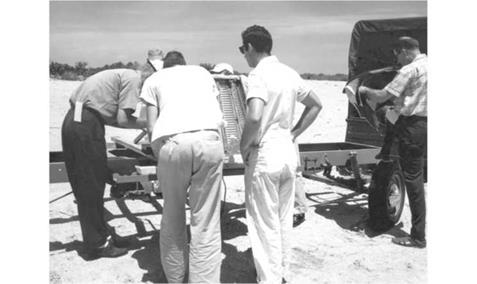
|
|
|
|
McDonnell’s Ralph Gendielle (at right) examines a hatch bolt after the test. Partly obscured behind him is John Yardley. (Photo courtesy Kansas Cosmosphere and Space Center) |
The following day NASA reported that the flight would likely be set for 18 July, but the space agency declined any further comment on the identity of the astronaut. They said they would reveal the name of the chosen astronaut on Monday, 24 hours ahead of the launch. Then, on 15 July, and to the surprise of many, Robert Gilruth finally confirmed to reporters that Grissom would be the prime pilot for the MR-4 mission, with Glenn acting as his backup. It was also announced that Grissom had chosen the call-sign Liberty Bell 7 for his spacecraft, and an engineer had stenciled the name in white paint onto the side of the capsule.
“One of the less vital problems I had was figuring out a name and an insignia for the capsule,” Grissom later revealed. “As the pilot, I had the prerogative of thinking up a name. I decided on Liberty Bell, because the capsule does resemble a bell. John Glenn felt that the symbolic number ‘seven’ should appear on all our capsules – in honor of the team – so this was added. Then one of the engineers got the bright idea
|
|
The hatch, still attached as planned to the door sill, rests on the ground. (Photo courtesy Kansas Cosmosphere and Space Center)
|
|
Grissom inspects the results of the hatch test. (Still from Spacecraft Films Project Mercury film set)
A girdle around the world 85
that we ought to dress Liberty Bell up by painting a crack on it just like the crack on the real one. No one seemed quite sure what the crack looked like, so we copied it from the ‘tails’ side of a fifty-cent piece.”16
Interestingly, Jerry Ter Horst of the North American Newspaper Alliance later claimed that the choice of Grissom as prime pilot for the MR-4 mission over John Glenn was the result of what he called “the Air Force factor.” As Ter Horst stated, this hint of inter-service rivalry for space flight honors came to him “unofficially and privately” from NASA sources.
“According to the sources, Capt. Grissom was destined to be chosen over Marine Lt. Col. Glenn of Arlington, Virginia, because of the Air Force’s primary interest in space and because the Navy already has an astronaut in Cdr. Alan B. Shepard, Jr., who made the May 5 flight.
“‘Gus’ Grissom, 35, is one of three astronauts from the Air Force. Col. Glenn, 40, is the only Marine astronaut. The Marine Corps, however, is actually a part of the Navy. Three of the astronauts, including Cdr. Shepard, are Navy pilots. None of the seven is an Army man.
“‘All things being equal in their personal readiness and training for this shot, the choice of Grissom over Glenn was indicated because of the Air Force factor,’ one source said privately. ‘Imagine how the Air Force would feel if it missed out on the first two flights,’ said another.
“There has been no hint of inter-service rivalry among the astronauts, who have lived and worked together as an inseparable team for two years. Officially, NASA has played down their basic membership in the armed forces because of the civilian nature of this country’s space program. Col. Glenn had been presumed in line for the first trip, but the nod went to Cdr. Shepard. Col. Glenn became his ‘backup’ man. Col. Glenn then became the seeded choice for the second manned flight into space. Capt. Grissom, from Mitchell, Indiana, apparently has been the secret NASA choice for several weeks – with full knowledge of the other astronauts.
“Sources also said that astronaut No. 3 will not necessarily be Col. Glenn. The ‘top three’ selection was only for the first two flights, it was said, and all seven astronauts will be in the running for subsequent flights – including Cdr. Shepard and Capt. Grissom.”17
On the Friday evening before flight week, Grissom attended a meeting on the preparedness of the Redstone and discussed some minor problems in loading liquid oxygen into the rocket. At the end of the meeting he admonished everyone to leave well enough alone by saying, “Don’t anybody fiddle with it over the weekend.” He then flew home to spend a few final hours with his family before returning to the Cape on Sunday.











